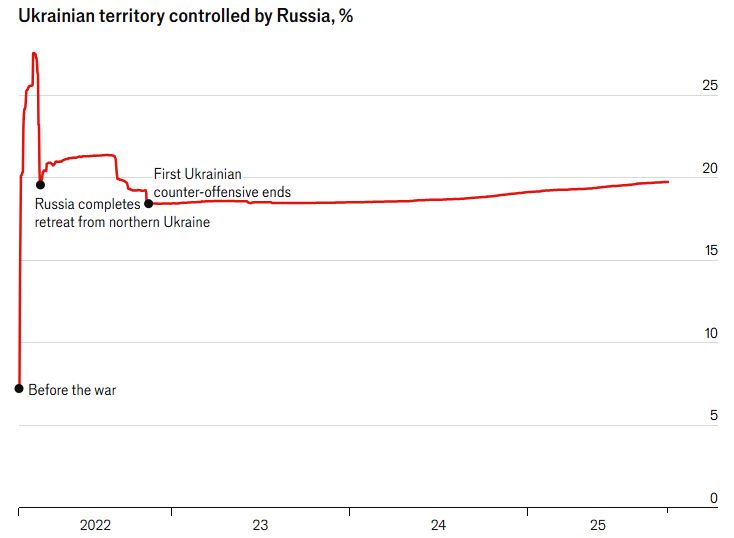Russia’s 2025 summer offensive in Ukraine has failed to achieve any major objectives, despite immense costs in both lives and equipment, The Economist reports. Since launching its campaign in May, Russia has gained just 0.4% of Ukrainian territory. Meanwhile, cities like Pokrovsk remain under Ukrainian control despite repeated assaults. The Economist’s new analysis suggests that if Russia continues advancing at this pace, it would take until June 2030 to seize the rest of the four oblasts it claims — Luhansk, Donetsk, Kherson, and Zaporizhzhia — and a staggering 103 years to occupy all of Ukraine.
Staggering losses with minimal gains
According to The Economist’s meta-estimate, Russian forces have suffered between 984,000 and 1,438,000 total casualties since the full-scale invasion began, including between 190,000 and 480,000 soldiers killed. More than 100,000 of those deaths occurred in 2025 alone. These figures are drawn from a combination of satellite data, territorial control shifts, and over 200 credible assessments from Western governments and independent researchers. In contrast, UALosses, a website tracking Ukrainian casualties, has catalogued 77,403 Ukrainian soldiers killed since 2022 and reports a further 77,842 missing. It records only 8,668 Ukrainian fatalities so far this year, though the true number is likely higher. Even if the actual figure were double, 2025 would still show a five-to-one kill ratio in Ukraine’s favor.
Manpower, drones, and the kill zone
The Economist notes that Ukrainian tactics—built around constant drone surveillance and long-range precision weapons—have made it nearly impossible for Russian forces to mass near the front without incurring devastating losses. Instead, Moscow sends small groups of soldiers into kill zones to try to capture positions. A breach in Ukrainian lines is difficult, and exploiting one with massed equipment is even harder. These conditions have made the summer’s fighting significantly more lethal for Russia than for Ukraine.
Russia’s early recruitment outpaced Ukraine’s by up to 15,000 monthly thanks to large bonuses, but heavy losses erased that lead. With only 40% of wounded returning and just 800,000 new 18-year-olds last year, Moscow may soon need even higher payouts or resort to conscription, The Economist notes.
War economy under pressure
The losses extend beyond manpower. Open-source equipment losses tracker Oryx has confirmed that Russia has lost at least 12,541 tanks and armored vehicles, 2,674 artillery and missile systems, 166 aircraft, and 164 helicopters. These figures represent minimum losses. Ukraine’s drone strike on Russian airfields in June may have destroyed up to one sixth of Moscow’s strategic bomber fleet. Replacing this equipment is neither quick nor cheap.
After a pause in late 2023 and early 2024, US aid resumed, helping Ukraine recover from shell shortages and higher losses. With renewed backing, Ukraine is now better equipped, as several allies have pledged defense spending exceeding Ukraine’s annual budget, The Economist reports.
Shift in war dynamics
Ukraine’s ability to strike inside Russia is also changing the war. While Ukraine’s economy remains under heavy bombardment, it is beginning to hit back using domestically produced drones and missiles. If the war continues to focus more on installations than territorial control, the advantage may no longer lie with Russia.
Read also
-
Trump rejects Tomahawk cruise missiles for Ukraine at meeting with Zelenskyy after call with Putin
-
“Putin outplayed Trump again”: Russia pulls US president into Budapest meeting on its terms, says expert
-
The Economist: Ukrainian-made drones and missiles disable 20% of Russian oil refining, pressuring war economy





